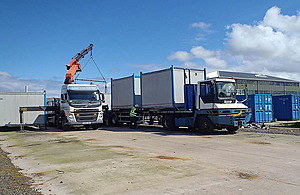Part of a £28.5 million flood alleviation scheme, the new East Hull Pumping Station will be built at the southern end of the Holderness Drain, where it meets the Humber in Marfleet, after city planners gave the go-ahead last month.
It will enable the discharge of water from Holderness Drain to the estuary at high tide when water levels in the drain are raised, pumping up to ten tonnes of water a second, reducing flood risk to areas in east Hull.
To ensure that the work is done safely given the current coronavirus situation everyone working on the new pumping station will be following strict Government guidelines in relation to social distancing.
The pumping station is phase one of the Holderness Drain Flood Alleviation Scheme, with work set to start on a second phase to create a flood relief area near the historic Castle Hill monument area, east of Bransholme and Sutton, later this year.
Andrew Barron, the Environment Agency’s senior flood risk advisor for Hull, said:
It is great news that this scheme is coming to fruition. Hull and the surrounding area is very low lying and this pumping station is vital to keep water moving into the Humber estuary.
This is part of a £200 million investment with partners in reducing flood risk in Hull and the East Riding over the last five years.
All our works are undertaken within Government guidelines, in particular social distancing to protect local people and those working on the new pumping station.
As an organisation we are doing everything we can to support our community, our government and the NHS by abiding by these measures.
The scheme is a partnership project with Hull City Council, East Riding of Yorkshire Council, the Humber Local Enterprise Partnership and Highways England.
Highways England contributed £5 million towards the scheme from its Environment Designated Fund, which helps to improve flood resilience and reduce flood risks to communities close to its network of roads.
Highways England assistant project manager Matt Armitage said:
We are delighted to be able to support the Environment Agency and contribute £5 million to this scheme.
When complete it will protect local homes and roads from flooding and reduce the need for local traffic to be diverted onto the A63, minimising future disruption along this key Hull route.
The Humber Local Enterprise Partnership secured £2.14 million towards the project through the Local Growth Fund as part of the Government’s commitment to the Northern Powerhouse. The project is part of the wider River Hull Integrated Catchment Strategy, which has seen an overall total Local Growth Fund investment of £3.8 million.
Lord Chris Haskins, Chair of the Humber LEP, said:
The Humber LEP is pleased to support this important project through the Local Growth Fund.
Communities across the Humber continue to be affected by flooding and we are very glad to see work begin on this flood alleviation scheme to help protect residents and businesses in Hull.
Councillor Mike Thompson, portfolio holder for neighbourhoods, communities and environment at Hull City Council, said:
We are delighted to see this critical work get under way. The pumping station is the first piece of a much bigger jigsaw and the work done in terms of partnership funding to get it to this stage.
These defence measures will help to minimise the impact of flooding to some of our area’s most vulnerable parts of land, and highlights the continued commitment we have to protecting homes from flooding.
Councillor Chris Matthews, portfolio holder for strategic management at East Riding of Yorkshire Council, said:
I’m delighted that work will soon start on this much needed scheme which will benefit so many residents.
This project is the latest component of the River Hull Integrated Catchment Strategy (RHICS) to move forward. The strategy provided the local framework for investment in flood alleviation in the River Hull Valley and was adopted by the partnership River Hull Board in 2015.
There is an existing pumping station by Hedon Road (A1033), built in 1949, but the Agency says it has reached its end of life, and it is more economically viable and beneficial to reducing flood risk to build a brand new structure downstream nearer the Holderness Drain’s confluence with the estuary.
The Holderness Drain was first built in the 18th century to drain carr lands on the east side of Hull. The new flood alleviation work is being carried to continue to maintain this historic drainage system.
To find out about flood risk in your area and to sign up to the Environment Agency’s free flood warning service, go to www.gov.uk/flood, or call Floodline on 0345 988 1188.
| George Hinton |
Communications Manager |
| Operational & Local Communications |
Defra Group Communications |
| 07342 099 435 |
george.hinton@environment-agency.gov.uk |

